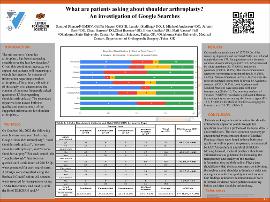| dc.contributor.author | Shepard, Samuel | |
| dc.contributor.author | Huges, Griffin | |
| dc.contributor.author | Stallings, Landon | |
| dc.contributor.author | Anderson, J. Michael | |
| dc.contributor.author | Scott, Jeremy | |
| dc.contributor.author | Hanson, Chad | |
| dc.contributor.author | Basener, Clint | |
| dc.contributor.author | Chalkin, Brian | |
| dc.contributor.author | Vassar, Matt | |
| dc.date.accessioned | 2023-11-02T20:45:54Z | |
| dc.date.available | 2023-11-02T20:45:54Z | |
| dc.date.issued | 2023-02-17 | |
| dc.identifier | ouhd_Shepard_whatarepatientsaskingabout_2023.pdf | |
| dc.identifier.citation | Shepard, S., Huges, G., Stallings, L., Anderson, J. M., Scott, J., Hanson, C., Basener, C., Chalkin, B., and Vassar, M. (2023, February 17). What are patients asking about shoulder arthroplasty? An investigation of Google searches. Poster presented at Research Week, Oklahoma State University Center for Health Sciences, Tulsa, Ok. | |
| dc.identifier.uri | https://hdl.handle.net/11244/339899 | |
| dc.description.abstract | Introduction: The utilization of shoulder arthroplasty has been increasing steadily over the last few decades. Given this continuous increase, we expect that patients will increasingly search the internet for sources of information regarding shoulder arthroplasty. The primary objective of this study is to characterize the content of the most frequently asked questions (FAQs) regarding shoulder arthroplasty. The secondary objective is to assess both the quality and transparency of the suggested information for shoulder arthroplasty. | |
| dc.description.abstract | Methods: On October 9th, 2022 the following search terms were searched using Google “shoulder arthroplasty”, “total shoulder arthroplasty”, “reverse shoulder arthroplasty”, and “reverse shoulder surgery.” For each search the “people also ask” function was queried until a minimum of 150 FAQs were generated for each search term. We recorded the individual FAQs along with the linked answer sources. All FAQs were classified using the Rothwell Classification. All sources were assessed for transparency using JAMA Benchmark and quality with the Brief DISCERN tool. | |
| dc.description.abstract | Results section: Our search returned a total of 1275 FAQs. After removing duplicates and unrelated FAQs our included sample size was 173. Fact questions were the most common classification type (102/173, 59%) followed by value questions (52/173,30%) and policy questions (19/173, 11.0%). The most common fact questions were related to technical details (42/103, 40.7%). Medical Practices (67/173, 38.7%) were the most encountered source type followed by Academic sources(60/173, 34.6%). Both Academic and Medical Practices were associated with poor transparency (Table 1.). The one-way analysis of variance (ANOVA) revealed a significant difference in mean quality scores among the 5 source types (F = 18.6, P <.001) with Medical Practices averaging the lowest score (16.1/30) compared to Commercial sources which were found to have the highest quality of all included sources (24.1/30). (Table 1) | |
| dc.description.abstract | Discussion: Patients seeking online information for shoulder arthroplasty appear to search Google for questions related to a plethora of technical details and restrictions. The most common source type encountered by patients are those of Medical Practices; these were found to have both poor quality as well as poor transparency as measured by JAMA Benchmark and Brief DISCERN. Our study has several limitations, JAMA benchmark and Brief DISCERN do not assess the accuracy of the information. Secondly, our study is cross-sectional and cannot be generalizable to other fields or other topics. Lastly, this study assessed online sources from one moment in time. Given the large amount of internet traffic Google experiences, web sources provided by the platform may change with time and search trends. Moving forward, medical practices should use validated tools as guidance for increasing the transparency and quality of the medical information they publish online. Physicians should know that their patients may be informing themselves about shoulder arthroplasty risks and management with low quality internet sources. Our findings reinforce the importance of well informed, evidence-based patient counseling before and after shoulder arthroplasty. | |
| dc.format | application/pdf | |
| dc.language | en_US | |
| dc.publisher | Oklahoma State University Center for Health Sciences | |
| dc.rights | The author(s) retain the copyright or have the right to deposit the item giving the Oklahoma State University Library a limited, non-exclusive right to share this material in its institutional repository. Contact Digital Resources and Discovery Services at lib-dls@okstate.edu or 405-744-9161 for the permission policy on the use, reproduction or distribution of this material. | |
| dc.title | What are patients asking about shoulder arthroplasty? An investigation of Google searches | |
| osu.filename | ouhd_Shepard_whatarepatientsaskingabout_2023.pdf | |
| dc.type.genre | Presentation | |
| dc.type.material | Text | |
| dc.subject.keywords | cross-sectional | |
| dc.subject.keywords | Google | |
| dc.subject.keywords | shoulder arthroplasty | |
